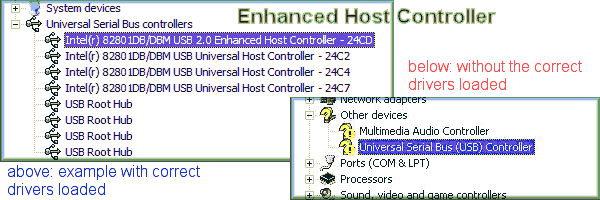Troubleshooting USB 2.0 Device Drivers
The Microsoft USB 2.0 driver may not be listed as an available update if third-party USB 2.0 drivers are installed on your computer. You may have to remove the third-party USB 2.0 drivers, and then install the Microsoft USB 2.0 driver from the Microsoft Update Web site.
The USB 2.0 drivers for Windows XP that are on Microsoft Update today only recognize devices using the NEC USB 2.0 EHCI controller chipset. The industry specification for Hi-Speed USB is called the Enhanced Host Controller Interface (EHCI ). That doesn't mean you have to buy an NEC-brand controller. The NEC chipset is fairly ubiquitous in the USB 2.0 world. That chipset is also the first one to be certified by the independent USB 2.0 testing body. Although the USB 2.0 drivers currently available on Microsoft Update only support the NEC controller, there should be an update soon that supports all EHCI-compliant controllers.
If you've made sure that everything on your computer is USB 2.0-compliant, and you're still getting low-speed results, you may not have the right drivers. Symptoms in Windows XP can include error messages such as “The Generic USB Hub is a HI-SPEED USB device and will function at reduced speed when plugged into a non-HI-SPEED port,” or “A HI-SPEED USB device is plugged into a non-HI-SPEED USB hub.” You may also see your high-speed controller card tagged with a yellow exclamation icon in Device Manager. The problem is that although you have a Hi-Speed hub or controller, Windows XP doesn't recognize it.
Universal Serial Bus 2.0 support in Windows XP
You may experience any of the following symptoms:
- • Your Hi-Speed Universal Serial Bus (USB) 2.0 device does not operate in Hi-Speed mode.
- • If you plug in a Hi-Speed USB 2.0 device, you receive any of the following warnings:
- The Generic USB Hub is a HI-SPEED USB device and will function at reduced speed when plugged into a non-HI-SPEED port.
- HI-SPEED USB Device Plugged into non-HI-SPEED USB Hub. A HI-SPEED USB device is plugged into a non-HI-SPEED USB hub.
- • An Enhanced Host Controller Interface-compliant (EHCI-compliant) USB host controller appears in Device Manager with an exclamation point in a yellow circle, or with status code 28.
These symptoms occur because Windows XP does not include support for EHCI host controllers. To resolve this problem, obtain the latest service pack for Windows XP. Microsoft has confirmed that this is a problem in the Microsoft products that are listed in the "Applies to" section. This problem was first corrected in Windows XP Service Pack 1.
Does my PC have USB 2.0 ports?
Most desktop and laptop computers sold after 2002 are USB 2.0 enabled. USB 2.0 enabled means that the computer has one or more USB-enhanced host controllers. To determine if your computer running the Windows XP or Windows Server 2003 operating system has a USB-enhanced host controller, follow these steps:
1. Start Device Manager. To do so, click Start, and then click Run. In the Open box, type devmgmt.msc, and then click OK.
2. In the Device Manager window, expand the Universal Serial Bus controllers node. Look for a host controller with the word "Enhanced" in the title. If you find one, your system has USB 2.0 capable ports and has the necessary host controller drivers.
3. If you do not find an enhanced host controller in step 2, expand the Other Devices section. Look for Universal Serial Bus (USB) Controller. If you find this item, your system has USB 2.0 capable ports, but you need to install drivers for this host controller. If you do not find this item, your system does not have any USB 2.0 ports.
Remember, Windows 2000 and Windows XP were released before USB 2.0 hardware was available, so the drivers were released for those operating systems in the service packs.
